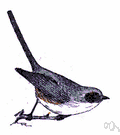bushtit
Also found in: Thesaurus, Acronyms, Wikipedia.
bush·tit
(bo͝osh′tĭt′)n.
A small, long-tailed bird (Psaltriparus minimus) of western North America, having predominantly gray plumage.
American Heritage® Dictionary of the English Language, Fifth Edition. Copyright © 2016 by Houghton Mifflin Harcourt Publishing Company. Published by Houghton Mifflin Harcourt Publishing Company. All rights reserved.
bushtit
(ˈbʊʃˌtɪt)n
(Animals) any small grey active North American songbird of the genus Psaltriparus, such as P. minimus (common bushtit): family Paridae (titmice)
Collins English Dictionary – Complete and Unabridged, 12th Edition 2014 © HarperCollins Publishers 1991, 1994, 1998, 2000, 2003, 2006, 2007, 2009, 2011, 2014
bush•tit
(ˈbʊʃˌtɪt)n.
a small songbird, Psaltriparus minimus, of the western U.S. and Mexico, that constructs long nests.
[1880–85]
Random House Kernerman Webster's College Dictionary, © 2010 K Dictionaries Ltd. Copyright 2005, 1997, 1991 by Random House, Inc. All rights reserved.
ThesaurusAntonymsRelated WordsSynonymsLegend:
Switch to new thesaurus
| Noun | 1. |  bushtit - active grey titmice of western North America bushtit - active grey titmice of western North Americagenus Psaltriparus, Psaltriparus - a genus of Paridae |
Based on WordNet 3.0, Farlex clipart collection. © 2003-2012 Princeton University, Farlex Inc.